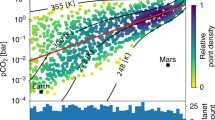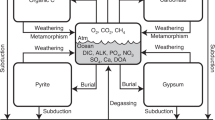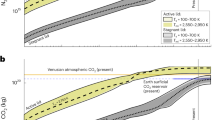Abstract
THE composition of the Earth's early atmosphere is a subject of continuing debate1–4. In particular, it has been suggested that elevated concentrations of atmospheric carbon dioxide would have been necessary to maintain normal surface temperatures in the face of lower solar luminosity in early Earth history5,6. Fossil weathering profiles, known as palaeosols, have provided semi-quantitative constraints on atmospheric oxygen partial pressure (po2) before 2.2 Gyr ago36,37. Here we use the same well studied palaeosols to constrain atmospheric pco2 between 2.75 and 2.2 Gyr ago. The observation that iron lost from the tops of these profiles was reprecipitated lower down as iron silicate minerals7–9, rather than as iron carbonate, indicates that atmospheric pco2 must have been less than 10–1.4atm—about 100 times today's level of 360 p.p.m., and at least five times lower than that required in one-dimensional climate models to compensate for lower solar luminosity at 2.75 Gyr. Our results suggest that either the Earth's early climate was much more sensitive to increases in pco2 than has been thought, or that one or more greenhouse gases other than CO2 contributed significantly to the atmosphere's radiative balance during the late Archaean and early Proterozoic eons.
This is a preview of subscription content, access via your institution
Access options
Subscribe to this journal
Receive 51 print issues and online access
$199.00 per year
only $3.90 per issue
Buy this article
- Purchase on Springer Link
- Instant access to full article PDF
Prices may be subject to local taxes which are calculated during checkout
Similar content being viewed by others
References
Ohmoto, H. & Felder, R. P. Nature 328, 244–246 (1987).
Walker, J. G. C. Palaeogeogr. Palaeoclimatol. Palaeoecol. 82, 261–289 (1990).
Towe, K. M. in Early Life on Earth (ed. Bengtson. S.) 36–47 (Nobel Symposium 84. Columbia University Press, New York, 1994).
Hayes, J. M. in Early Life on Earth (ed. Bengtson. S.) 220–236 (Nobel Symposium 84, Columbia University Press, New York, 1994).
Kasting, J. F. Science 259, 920–926 (1993).
Kasting, J. F. Precambr. Res. 34, 205–229 (1987).
Button, A. Information Circular 133 (Economic Geology Research Unit. Univ. Witwatersrand, 1979).
Button, A. & Tyler, N. Econ. Geol. 75, 686–709 (1981).
Macfarlane, A. W., Danielson, A. & Holland, H. D. Precambr. Res. 65, 297–317 (1994).
Postma, D. J. sedim. Petrol. 47, 1089–1098 (1977).
Postma, D. Chem. Geol. 31, 225–244 (1981).
Sutton, S. J. & Maynard, J. B. Can. J. Earth Sci. 30, 60–76 (1993).
Klein, C. in Iron Formation: Facts and Problems (eds Trendall, A. F. & Morris, R. C.) 417–469 (Developments in Precambrian Geology 6, Elsevier, Amsterdam, 1983).
Eugster, H. P. & Chou, I.-M. Econ. Geol. 68, 1144–1168 (1973).
Greenberg, J. & Tomson, M. Appl. Geochem. 7, 185–190 (1992).
Bruno, J., Wersin, P. & Stumm, W. Geochim. cosmochim. Acta 56, 1149–1155 (1992).
Cotter, R. D., Young, H. L., Petri, L. R. & Prior, C. H. USGS Water Supply Paper 1759-B-E (1965).
Baker, J. A. USGS Water Supply Paper 1257 (1955).
Wunsch, D. R. Kentucky Geological Survey Thesis Series 5, XI (1993).
Powell, J. D. & Larson, J. D. USGS Water Supply Pap. 2274 (1985).
Poth, C. W. Bulletin W16, 4th series (Pennsylvania Geological Survey, 1963).
Poth, C. W. Bulletin Water Resources report 36, 4th series (Pennsylvania Geological Survey, 1973).
Williams, D. R. & McElroy, T. A. USGS Open File Report 90–384 (1991).
May, F. Mineralog. Mag. 58A, 577–578 (1994).
Pinto, J. P. & Holland, H. D. Geol. Soc. Am. spec. Pap. 216, 21–34 (1988).
Arndt, N. T., Nelson, D. R., Compston, W., Trendall, A. F. & Thorne, A. M. Austr. J. Earth Sci. 38, 261–281 (1991).
Gough, D. O. Solar Physics 74, 21–34 (1981).
Kasting, J. F. & Grinspoon, D. H. in The Sun in Time (eds Sonett, C. P., Giampapa, M. S. & Matthews, M. S.) 447–462 (Univ. Ariz., Tucson, 1991).
Hoffman, P. F. Nature 375, 537–538 (1995).
Rossow, W. B., Henderson-Sellers, A. & Weinreich, S. K. Science 217, 1245–1247 (1982).
Cess, R. D. et al. J. Geophys. Res. 95, 16601–16615 (1990).
Sagan, C. & Mullen, G. Science 177, 52–56 (1972).
Kiehl, J. T. & Dickinson, R. E. J. Geophys. Res. 92, 2991–2998 (1987).
Sagan, C. & Chyba, C. Abstr. 1st Int. Conf. on Circumstellar Habitable Zones, 2 (NASA, Ames Research Center, 1994).
Buick, R. et al. Nature 375, 574–577 (1995).
Holland, H. D. The Chemical Evolution of the Atmosphere and Oceans (Princeton Univ. Press, 1984).
Holland, H. D. & Beukes, N. J. Am. J. Sci. 290A, 1–34 (1990).
Prasad, N. & Roscoe, S. M. Geol. Surv. Can. Pap. 91-IC, 43–54 (1991).
Author information
Authors and Affiliations
Rights and permissions
About this article
Cite this article
Rye, R., Kuo, P. & Holland, H. Atmospheric carbon dioxide concentrations before 2.2 billion years ago. Nature 378, 603–605 (1995). https://doi.org/10.1038/378603a0
Received:
Accepted:
Issue Date:
DOI: https://doi.org/10.1038/378603a0
This article is cited by
-
Metal ion effect on pore enlargement in solid acid catalyst and CO2 decomposition
Journal of Porous Materials (2023)
-
Greenalite-Chamosite composition, geothermometry and oxygen fugacity variations in pisolitic ironstone and carbonates of the Chilpi Group: implication on Paleoproterozoic seawater chemistry
Physics and Chemistry of Minerals (2023)
-
Pyropia yezoensis genome reveals diverse mechanisms of carbon acquisition in the intertidal environment
Nature Communications (2020)
-
Extreme sensitivity in Snowball Earth formation to mountains on PaleoProterozoic supercontinents
Scientific Reports (2019)
-
Snowball Earth at low solar luminosity prevented by the ocean–atmosphere coupling
Acta Geochimica (2019)
Comments
By submitting a comment you agree to abide by our Terms and Community Guidelines. If you find something abusive or that does not comply with our terms or guidelines please flag it as inappropriate.



